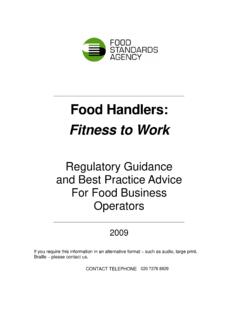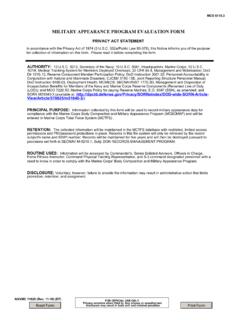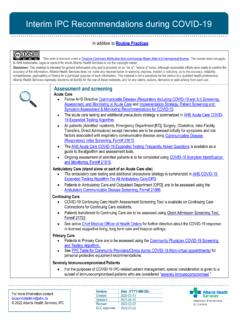Transcription of A LEADER’S GUIDE TO SOLDIER HEALTH AND FITNESS
1 *ATP LEADER S GUIDE TO SOLDIER HEALTH AND FITNESS FEBRUARY 2016 DISTRIBUTION RESTRICTION. Approved for public release; distribution is unlimited. *This publication supersedes FM , Combat and Operational Stress Control Manual for Leaders and Soldiers,dated 18 March 2009. Headquarters, Department of the Army This publication is available at Army Knowledge Online ( ). To receive publishing updates, please subscribe at *ATP Restriction: Approved for public release; distribution is unlimited. *This publication supersedes FM , Combat and Operational Stress Control Manual for Leaders andSoldiers dated 18 March 2009. i Army Techniques Publication (ATP) No.
2 Headquarters Department of the Army Washington, DC, 10 February 2016 A Leader s GUIDE to SOLDIER HEALTH and FITNESS Contents Page v INTRODUCTION .. vi Chapter 1 READY AND RESILIENT CAMPAIGN .. 1-1 Section I Medical Readiness .. 1-1 Behavioral HEALTH .. 1-1 Posttraumatic Stress Disorder .. 1-2 Traumatic Brain Injury .. 1-2 Pain Management .. 1-3 Polypharmacy .. 1-4 Section II Personnel Readiness .. 1-4 Suicide Prevention .. 1-5 Comprehensive SOLDIER and Family FITNESS Program .. 1-5 Deployment HEALTH Assessment Program .. 1-5 Individual Medical Readiness .. 1-6 Chapter 2 PERFORMANCE TRIAD .. 2-1 Section I Sleep .. 2-1 Sleep Management in the Operational Environment.
3 2-1 Sleep Environment and Critical Factors Related to Good Sleep hygiene .. 2-2 Sleep Loss .. 2-5 Section II Activity .. 2-7 Physical Training 2-7 Functional FITNESS 2-8 Section III Nutrition .. 2-8 Nutritional Guidance .. 2-8 Dietary Supplements .. 2-9 Hydration .. 2- 10 Contents ii ATP 10 February 2016 Chapter 3 COMPREHENSIVE SOLDIER AND FAMILY FITNESS PROGRAM .. 3-1 Section I Overview .. 3-1 Section II Educational 3-2 Chapter 4 POTENTIALLY LIFE THREATENING THOUGHTS AND BEHAVIORS .. 4-1 Section I Threat of Suicide .. 4-1 Section II Threat of Violence to Others and the Risk of Unlawful Behavior .. 4-2 Unit Risk Factors.
4 4-2 Individual Risk Factors Affecting Soldiers .. 4-3 Individual Behaviors of Soldiers at Risk .. 4-3 Chapter 5 ARMY HEALTH PROMOTION PROGRAM .. 5-1 Section I HEALTH Promotion Program .. 5-1 Section II Behavioral HEALTH .. 5-2 Behavioral HEALTH Promotion .. 5-2 Stress Management .. 5-2 Combat and Operational Stress Control .. 5-3 Suicide Prevention .. 5-3 Responsible Sexual Behavior .. 5-3 Army Substance Abuse Program .. 5-4 Tobacco Cessation .. 5-4 Section III Physical HEALTH .. 5-4 Physical FITNESS .. 5-5 Injury Prevention .. 5-5 Ergonomics .. 5-5 Oral HEALTH .. 5-6 Body Composition Program .. 5-6 Chapter 6 FIELD hygiene AND 6-1 Section I HEALTH Threats to Soldiers in the Field.
5 6-1 Section II SOLDIER Preventive Medicine Measures .. 6-2 Personal hygiene .. 6-2 Arthropods, Rodents, and Other Animal Threats .. 6-3 Section III Field Sanitation Teams .. 6-3 Field Sanitation Team Protection and Sanitation Duties .. 6-4 Field Sanitation Team Arthropod and Rodent Control Duties .. 6-4 Section IV Commander and Leader Preventive Medicine Measures .. 6-5 Chapter 7 COMBAT AND OPERATIONAL STRESS REACTION IDENTIFICATION, PREVENTION, MANAGEMENT AND CONTROL .. 7-1 Section I Reactions to Combat and Operational Stress .. 7-1 Section II Forms of Combat and Operational Stress .. 7-3 Potentially Traumatic Events.
6 7-3 Combat and Operational Stress Behaviors .. 7-3 Section III Combat and Operational Stress Reactions .. 7-5 Section IV Referral of Soldiers Experiencing Combat and Operational Stress Reactions and Other Stress-Related 7- 10 Contents 10 February 2016 ATP iii Voluntary Referrals .. 7- 11 Command-Directed 7- 11 Section V Preventing and Managing Combat and Operational Stress 7- 13 Cohesion and Morale .. 7- 13 Stress- Reduction Techniques for Leaders .. 7- 14 Performance Degradation Preventive Measures .. 7- 17 Section VI Role of Religious Support .. 7- 18 Section VII Role of Unit Behavioral Assets .. 7- 19 Mental HEALTH Sections.
7 7- 19 Mental HEALTH Section Functions .. 7- 20 Chapter 8 COMMAND LEADERSHIP ACTIONS AND COMBAT AND OPERATIONAL STRESS CONTROL PROGRAMS .. 8-1 Section I Unit Behavioral HEALTH Needs Assessment .. 8-1 Section II Effective Leadership .. 8-2 Leaders are Reliable and Confident .. 8-2 Family Readiness Group .. 8-6 Section III Traumatic Event Management and Leader-Led After Action Debriefing .. 8- 11 Traumatic Event Management .. 8- 11 Cool Down Meetings .. 8- 13 Leader-Led After Action Debriefing .. 8- 13 Effectively Sustain Performance .. 8- 15 Section IV Effective Combat and Operational Stress 8- 17 Minimize Stress.
8 8- 17 Mobilization .. 8- 17 Deployment .. 8- 20 Section V SOLDIER Resiliency and Combat and Operational Stress Control .. 8- 22 Section VI Leadership Actions and Interventions for Combat and Operational Stress Reactions .. 8- 23 Section VII Combat and Operational Stress Reaction Management Guidelines .. 8- 24 Brevity .. 8- 24 Immediacy .. 8- 24 Contact .. 8- 25 Expectancy .. 8- 25 Proximity .. 8- 25 8- 25 Section VIII Safety Considerations .. 8- 25 Chapter 9 BEHAVIOR AND PERSONALITY 9-1 Section I Medical Readiness Responsibilities .. 9-1 Section II Personality Disorders .. 9-4 Behavioral HEALTH Status.
9 9-4 Documenting Maladaptive Patterns of Behavior and Performance .. 9-4 Chapter 10 POSTTRAUMATIC STRESS DISORDER .. 10-1 Contents iv ATP 10 February 2016 Chapter 11 MILD TRAUMATIC BRAIN INJURY/CONCUSSION .. 11-1 Section I Mild Traumatic Brain Injury Overview .. 11-1 Educate .. 11-2 Train .. 11-2 Treat .. 11-2 Track .. 11-3 Section II Commander s Guidance for Management of Mild Traumatic Brain Injury .. 11-3 GLOSSARY .. Glossary-1 REFERENCES .. References-1 INDEX .. Index-1 Figures Figure 7-1. Combat and operational stress effect model .. 7-2 Tables Introductory Table-1. Rescinded Army terms .. vii Table 1-1. Symptoms of closed head injuries.
10 1-3 Table 2-1. Basic sleep scheduling information .. 2-2 Table 2-2. Basic sleep environment and related factors .. 2-3 Table 2-3. Using caffeine under various conditions of sleep deprivation .. 2-4 Table 7-1. Combat stressors and operational stressors .. 7-1 Table 7-2. Adaptive stress reactions .. 7-3 Table 7-3. Mild stress reactions .. 7-6 Table 7-4. Severe stress reactions .. 7-6 Table 10-1. Symptoms of posttraumatic stress disorder .. 10-1 Table 11-1. Effects of mild traumatic brain injuries, or concussions, on the SOLDIER and combat mission .. 11-1 Table 11-2. Injury, evaluation, and distance checklist .. 11-3 Table 11-3.














